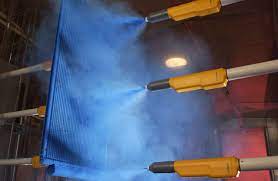Powder coating technology has seen a remarkable evolution over the years, significantly impacting industries ranging from automotive to home appliances. The heart of this transformative journey lies in the development of powder coating guns. This post delves into the progression of these guns, exploring the milestones that have defined their evolution.
The Humble Beginnings: First-Generation Manual Guns
In the early days, the first-generation manual powder coating guns were a groundbreaking innovation. These were simple in design yet marked a significant leap from traditional liquid painting methods. They primarily relied on compressed air to spray powder particles onto surfaces. The process, though rudimentary, opened up a new world of possibilities in terms of finish and durability. However, these manual guns had limitations in terms of efficiency and finish consistency, often requiring skilled operators to achieve the desired results. Each stroke of the gun was a dance between the operator’s expertise and the machine’s capability, laying the foundation for more sophisticated developments.
Introducing Automated Electrostatic Guns
The introduction of automated electrostatic guns was a game-changer in the powder coating industry. These advanced guns used electrostatic charges to ensure that the powder particles adhered more effectively to the target surfaces. This innovation not only improved the quality of the coating but also significantly reduced waste. The transition from manual to automated systems symbolized a leap towards efficiency and precision. Industries began to witness a transformation as these guns allowed for faster production lines and uniform coating applications, paving the way for large-scale operations.
Digital Controls Revolutionize Consistency
The integration of digital controls into powder coating guns marked another pivotal point in their evolution. These controls allowed for unprecedented precision in regulating the flow and pattern of the powder. The digital era introduced an element of consistency that was previously unattainable. Operators could now achieve uniform finishes with minimal effort and adjust settings for different coating requirements. This technological advancement ensured that even the most intricate parts could be coated with a level of precision that manual or earlier automated systems could not match.
Modular and Quick Color Change Designs
As the demand for versatility in powder coating increased, manufacturers responded with modular and quick color change designs. These innovative guns were designed to be easily adaptable, allowing for rapid color changes with minimal downtime. This flexibility became crucial for businesses that needed to switch between different color schemes quickly. The modular design not only streamlined the color change process but also enhanced the overall efficiency of the powder coating operation, catering to the dynamic needs of various industries.
Integrating Data Connectivity and Feedback Systems
The integration of data connectivity and feedback systems in powder coating guns represented a significant stride towards smarter manufacturing. These systems allowed for real-time monitoring and adjustments, ensuring optimal performance and quality control. The data collected from the coating process could be analyzed to identify trends and areas for improvement. This level of connectivity and feedback opened up new possibilities for predictive maintenance and process optimization, marking a shift towards data-driven manufacturing practices.
The Future with AI and Smart Technology
Looking towards the future, AI and smart technology are set to revolutionize powder coating guns even further. The potential integration of artificial intelligence could lead to autonomous systems capable of self-adjusting to achieve the perfect coat. Smart technology promises to bring about a new era of efficiency, precision, and customization. The future of powder coating guns lies in their ability to learn from each application, continuously improving and adapting to the evolving demands of industries.
In conclusion, the journey of powder coating guns from manual to smart technology-enabled devices is a testament to human ingenuity and the relentless pursuit of innovation. Each stage in their evolution has brought about significant improvements in efficiency, quality, and versatility. As we look forward to the future, it’s exciting to imagine how these tools will continue to evolve, shaping the landscape of manufacturing and finishing processes.

